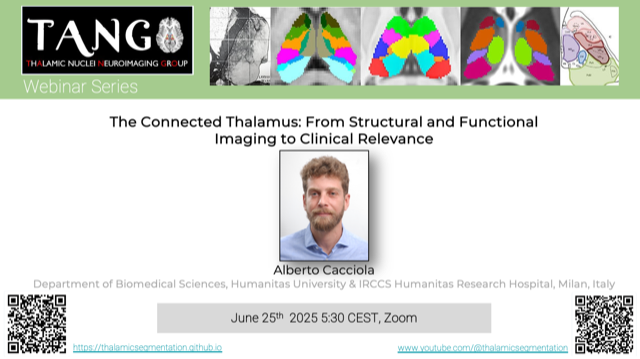Upcoming Events: Save the date!

Webinar link:https://unil.zoom.us/j/97377510032
Contact thalamicsegmentation@gmail.com
Description:
The thalamus is a heterogeneous structure composed of multiple nuclei, each with distinct cytoarchitectonic properties, connectivity profiles, and functional roles. Unlike other subcortical systems, principal thalamic nuclei are not interconnected. Instead, they are tightly and selectively linked to specific cortical and subcortical targets, enabling them to support a broad range of specialized functions. This modular organization, combined with the thalamus’s ability to switch between relay and burst firing modes, underpins its critical role in modulating whole-brain network activity. In this talk, we will explore how modern neuroimaging methods, including track density imaging, structural-functional connectivity analyses, and gradient-based mapping, are reshaping our understanding of thalamic anatomy and its clinical relevance. These approaches allow for a more nuanced, high-resolution depiction of thalamic nuclei and their connectivity patterns, overcoming some of the limitations of traditional MRI sequences. We will also discuss how these neuroimaging tools can be applied to refine and guide target selection for thalamotomy in neurological disorders, highlighting the value of personalized connectivity-informed planning.
Presenters: Alberto Cacciola, Department of Biomedical Sciences, Humanitas University, Milan, Italy & IRCCS Humanitas Research Hospital, Milan, Italy.
Alberto Cacciola, MD, is an associate professor of human anatomy at Humanitas University, Milan, Italy. He received his medical degree and specialization at the University of Messina, Italy, and his international experience as a computational neuroanatomist includes research fellowships at the Technische Universität Dresden in Germany and a visiting period at Tsinghua University, Beijing, China. In 2021, he funded and directed the Brain Mapping Lab at the University of Messina, dedicated to advancing the understanding of brain structure and function through computational neuroanatomy.
His research revolves around neuroscience, and in particular neuroimaging and connectomics. His main goals include advancing the understanding of cortico-subcortical interactions, developing novel approaches for subcortical segmentations and connectivity analysis, and identifying neuroimaging-based biomarkers for brain disorders and brain tumors.
Past events & webinars
Virtual event, 4th June 2025, Melissa Thalhammer (Technical University of Munich): The thalamus in neurodevelopmental disorders: moving from group avarage to individual-based analyses
7th May 2025, Shail Segobin & Michael Hornberger on behalf of the TANGO group: Rethinking the Role of the Thalamus in Neuroimaging: Advances and Challenges in Thalamic Nuclei Segmentation
30th-31st October 2023, Conference: Thalamus Anatomy and Connectomics Conference: A two-days hybrid conference with talks and discussions
Virtual event, 25th July 2023, OHBM 2023 Roundtable: In vivo thalamic nuclei imaging, segmentation, and applications: pitfalls and perspectives
Virtual event, 15th March 2023, Anneke Alkemade (University of Amsterdam): Anatomical mapping to study human subcortical function
Virtual event, 18th January 2023, João Jorge (Swiss Center for Electronics and Microtechnology): A quest for contrast: towards non-invasive high-resolution thalamic nuclei differentiation with multi-contrast 7T MRI
Virtual event, 30th November 2022, Katharina von Kriegstein (Technische Universität Dresden): The tiny and the fast: The role of sensory thalamus in speech recognition
Virtual event, 28th September 2022, Mac Shine (University of Sidney): The systems-level impact of the human thalamus – evidence from multi-modal neuroimaging
Virtual event, 19-21 January 2022: E-symposium: Thalamic nuclei imaging, segmentation and applications
